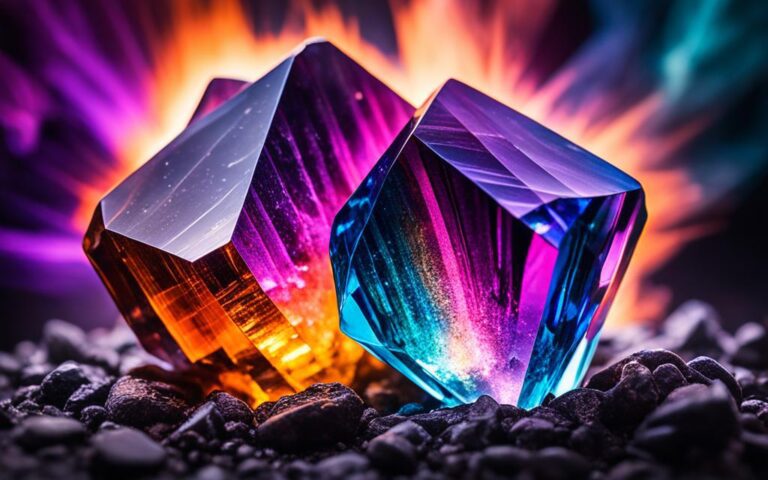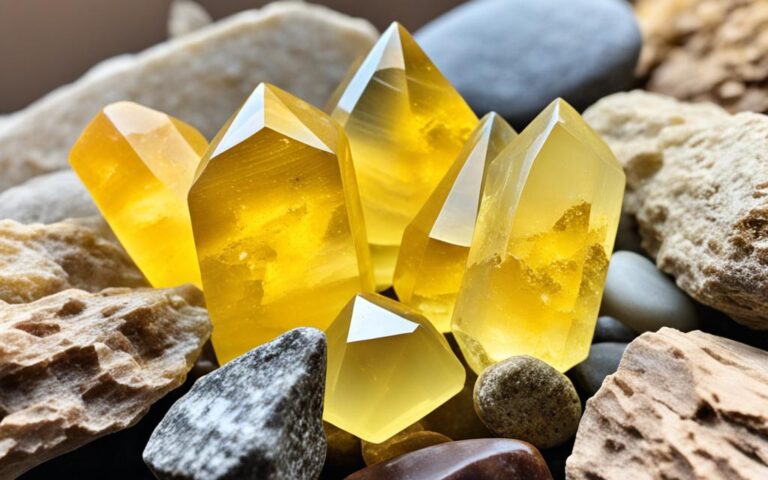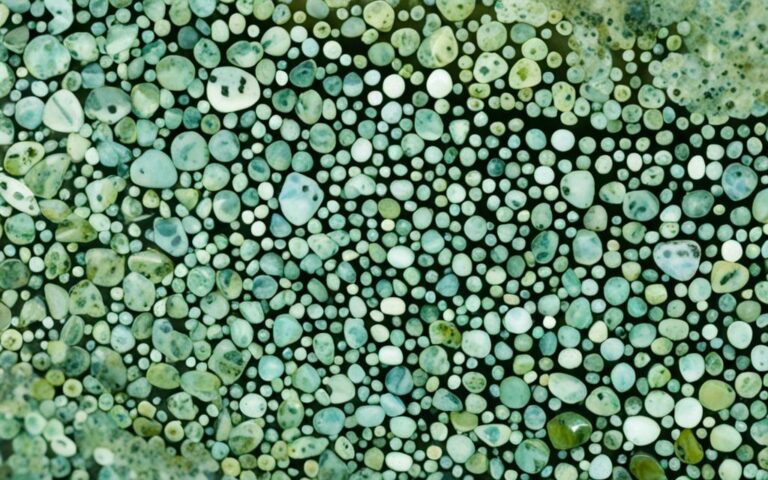Flower Rhyolite: Nature’s Volcanic Gemstone Wonder
Did you know that rhyolite is a rare and captivating volcanic rock? It can have over 70% silica in its makeup. This makes it very hard, with a Mohs hardness of 6 to 7. Its beauty and durability have made it popular for jewelry and art.
This guide will explore the world of Flower Rhyolite. We’ll look at its origins and how it’s used today. You’ll learn about its unique beauty and its history.
Key Takeaways
- Rhyolite is a silica-rich, durable volcanic rock with a Mohs hardness ranging from 6 to 7.
- Rhyolite is known for its diverse colors and intricate patterns, making it a popular material for jewelry, art, and collectibles.
- Rhyolite is found in notable deposits around the world, including Yellowstone National Park, the Taupo Volcanic Zone in New Zealand, and Pantelleria Island in Italy.
- Rhyolite has been used since prehistoric times for various purposes, including tools, weapons, and construction materials.
- Rhyolite is believed to have metaphysical and healing properties, promoting emotional well-being, self-esteem, and spiritual growth.
Introduction to Flower Rhyolite
Definition and Description
Rhyolite is a gemstone known for its vibrant colors and earthy tones. It’s a type of felsic extrusive igneous rock made mostly of quartz and alkaline feldspar. This gives it a unique look and structure.
Its chemical makeup is similar to granite, making it a special type of volcanic rock. The patterns in rhyolite come from how it forms. When silica-rich magma cools, it creates beautiful swirling designs. This is why it’s called “Flower Rhyolite.”
Origin of the Name
The name “rhyolite” comes from the Greek word “rhyax,” meaning “a stream of lava.” This name fits because rhyolite forms from flowing, cooling magma. This process creates its unique patterns and textures.
Rhyolite comes in many colors like gray, green, cream, and sometimes brown or red. It’s hard, with a Mohs hardness of 6 to 6.5. This makes it both beautiful and useful throughout history.
“Rhyolite is a multi-colored gemstone with warm, fuzzy vibes associated with love, hope, and joy.”
Geological Origins and Formation
Rhyolite is a fascinating volcanic rock that comes from a complex journey. It forms from explosive eruptions and quick cooling. About 70-77% of rhyolite is silica, making its magma very thick. This thickness leads to powerful eruptions, creating unique rhyolite rocks.
Volcanic Eruptions and Rapid Cooling
27 million years ago, a huge volcanic eruption made the Turkey Creek Caldera, about 12 miles wide. This eruption was key to making rhyolite. The fast cooling stopped big crystals from forming, giving rhyolite its fine texture.
Later, the rhyolite tuff, made from ash and molten rock, settled and hardened. Erosion shaped it into the stunning rock pillars at Chiricahua National Monument in Arizona. This erosion, along with the area’s unique geology, makes rhyolite so diverse and beautiful.
Geological Settings for Rhyolite Formation
- Rhyolite mainly forms in volcanic areas with a lot of silica. These include places like continental volcanic arcs, rift zones, and hot spots.
- The Chiricahua Mountains, where Chiricahua National Monument is, are in southern Arizona’s Basin and Range Province. This area is known for its varied geology.
- Rhyolite is the most silica-rich volcanic rock. It’s made mostly of quartz, sanidine, and plagioclase.
The fast cooling of rhyolite lava and its unique geology make it a fascinating rock. Its patterns and colors have caught the interest of geologists and artists.
Physical Properties and Characteristics
Rhyolite is a fascinating volcanic rock with unique physical traits. It’s fine-grained and can look glassy or have tiny crystals. You might find quartz, feldspar, and other minerals in it, making it interesting to look at.
The rhyolite texture can be smooth or have intricate bands. This shows how it was formed. The rhyolite crystal structure is also interesting, with big crystals in the rock. These crystals make the rock stand out.
Rhyolite comes in many colors like gray, brown, red, green, and yellow. These colors come from different minerals and stuff inside the rock. Each adds its own special look to the rock.
| Physical Property | Range or Characteristic |
|---|---|
| Silica Content | Over 70% SiO2 |
| Mohs Hardness | 6 to 7 |
| Density | 2.4 to 2.6 g/cm³ |
| Color Variations | Light to dark shades of gray, brown, red, green, and yellow |
Rhyolite is a true wonder of nature, with amazing physical traits. It invites us to explore and enjoy its unique beauty.
Chemical Composition and Mineralogy
Rhyolite is a fascinating volcanic rock known for its unique chemical makeup and mineral content. It’s packed with silica, with levels between 69% and 77%. This high silica content, along with certain minerals, makes rhyolite stand out.
The main minerals in rhyolite are felsic ones like quartz, alkali feldspar, and plagioclase feldspar. These can make up more than 20% of the rock. They give rhyolite its light color and low density.
Rhyolite also has smaller amounts of mafic minerals like biotite, hornblende, and pyroxene. These minerals, along with silica, create the varied colors and textures in rhyolite.
| Mineral | Typical Range (%) |
|---|---|
| Quartz | 20-40% |
| Alkali Feldspar | 40-90% |
| Plagioclase Feldspar | 10-40% |
| Biotite | 0-10% |
| Hornblende | 0-10% |
The makeup of rhyolite shows the complex geological processes behind it. Knowing about rhyolite chemical composition and rhyolite mineralogy helps us see why it’s so special.
Flower Rhyolite: Nature’s Artistic Masterpiece
Rhyolite is known for its stunning patterns, often called “flower rhyolite” because of their beauty. These patterns and flow banding come from the complex way it forms. This includes the fast cooling and setting of magma rich in silica.
Distinctive Patterns and Flow Banding
The flow banding in rhyolite creates beautiful, swirling designs that look like flower petals. These patterns happen when the molten rhyolite cools and sets, keeping the movement of the lava flow. The different layers of color add depth and make the material more interesting.
Diverse Color Combinations
- Rhyolite’s colors range from bright to soft, making it even more beautiful.
- The mix of colors comes from the minerals in it and the unique way it was formed.
- It has everything from bright reds and oranges to calm blues and greens. This shows nature’s amazing creativity.
Flower rhyolite’s patterns and colors are a true work of nature. They show the power and beauty of the Earth’s processes.
Varieties of Rhyolite
Rhyolite is a fascinating volcanic rock with many different types. Each type has its own special look and uses. From the beautiful flow-banded patterns to the eye-catching obsidian-rhyolite and the unique perlitic textures, these types show how versatile and artistic rhyolite is.
Flow-Banded Rhyolite: Lava’s Rhythmic Dance
Flow-banded rhyolite stands out with its striking banding. These bands come from the lava flowing in a rhythmic way. This creates layers of different minerals and textures. The flow-banding looks amazing and makes flow-banded rhyolite great for jewelry, carvings, and decorations.
Obsidian-Rhyolite: Volcanic Glass Meets Crystalline Beauty
Obsidian-rhyolite, also called “snowflake obsidian,” is a mix of obsidian and rhyolite. It has spherulitic or vesicular textures with obsidian in the rhyolite. The mix of glassy obsidian and crystalline rhyolite looks stunning. This makes obsidian-rhyolite popular for art and decorations.
Perlitic Rhyolite: Volcanic Pearls of Beauty
Perlitic rhyolite is known for its glassy look and perlitic fractures. It looks like rounded masses or pieces. This type forms when lava cools fast, giving it a pearlescent look. Perlitic rhyolite’s beauty makes it great for jewelry, decorations, and building materials.
These rhyolite types show the amazing variety and natural beauty of this volcanic rock. From the beautiful flow-banded patterns to the striking obsidian-rhyolite and the captivating perlitic textures, they all inspire and amaze us.
| Rhyolite Variety | Distinctive Features | Key Applications |
|---|---|---|
| Flow-Banded Rhyolite | Distinctive banding patterns created by the rhythmic flow of lava | Jewelry, carvings, decorative items |
| Obsidian-Rhyolite | Combination of glassy obsidian and crystalline rhyolite, creating a unique “snowflake” appearance | Artistic and decorative applications |
| Perlitic Rhyolite | Glassy texture with distinctive perlitic fractures, often appearing as rounded masses or fragments | Jewelry, decorative items, construction materials |
Historical Significance and Cultural Use
Rhyolite is a fascinating volcanic rock that has played a big role in human history and culture. Its special look and properties have made it very valuable for many uses over the years.
Ancient Tools and Weapons
Long ago, people saw how useful rhyolite was. They used it to make important tools and weapons. They turned it into points for throwing, scrapers, and more. These items were key to their daily life and survival.
The rhyolite historical significance as a material for tools and weapons shows its big impact on human history.
Ornamental and Decorative Applications
Rhyolite is also loved for its beauty. It’s often used for rhyolite ornamental use and rhyolite decorative use in many cultures. Its eye-catching patterns and colors have been used in carvings, beads, and more. This shows how much people value rhyolite cultural use.
Today, rhyolite is still prized for its looks. It’s used in jewelry, art, and as a collectible mineral. Its unique traits and lasting beauty keep it a key part of our cultural heritage.
Modern Uses and Applications
Rhyolite, a stunning volcanic gemstone, has many modern uses. It’s known for its versatility and unique features. Rhyolite is often used in jewelry making. Its patterns, colors, and hardness make it perfect for cabochons, beads, and jewelry pieces. It adds beauty to necklaces, earrings, bracelets, and rings.
Rhyolite is also popular for carvings and sculptures. Artists love its flow banding and textures. They turn rhyolite into beautiful figures and decorative items. These pieces can be found in homes and public places.
Jewelry and Gemstone Crafting
- Rhyolite’s unique patterns and colors make it a popular choice for cabochons, beads, and other jewelry components.
- Rhyolite jewelry, such as necklaces, earrings, bracelets, and rings, showcases the stone’s natural beauty.
- The hardness of rhyolite (Mohs hardness of 6-7) makes it a durable and long-lasting gemstone material.
Carvings and Sculpture
Rhyolite’s flow banding and textures are perfect for artists and sculptors. They use it to create detailed figurines and decorative items. Rhyolite carvings and sculptures are found in homes, public spaces, and art galleries, showing off the stone’s beauty.
Construction and Building Materials
Rhyolite is also used in construction because it’s durable and easy to find. It’s used as a building stone and aggregate in many projects. This adds strength and beauty to buildings.
| Modern Use | Description |
|---|---|
| Jewelry and Gemstone Crafting | Rhyolite’s unique patterns and colors make it a popular choice for cabochons, beads, and other jewelry components. Rhyolite jewelry, such as necklaces, earrings, bracelets, and rings, showcases the stone’s natural beauty. |
| Carvings and Sculpture | Rhyolite’s distinct flow banding and intricate textures have made it a favored material for artists and sculptors. From intricate figurines to ornamental objects, rhyolite carvings and sculptures grace homes, public spaces, and art galleries. |
| Construction and Building Materials | Owing to its durability and availability, rhyolite has also found application as a construction material. The stone is utilized as a building stone and aggregate in various construction projects. |
Metaphysical and Healing Properties
Rhyolite is a gemstone that many in the metaphysical world value for its rhyolite spiritual benefits and rhyolite healing properties. It’s known to boost creativity and inspire new ideas. It’s also seen as a stone that helps with emotional healing, letting go of past hurts, and feeling better overall.
Spiritual and Emotional Benefits
Rhyolite is a key stone in rhyolite crystal healing. It helps with spiritual growth and deepens meditation. It connects people with higher spiritual levels. This stone brings balance and harmony, helping you connect with your inner self and nature.
Crystal Healing and Meditation
When meditating with rhyolite, it helps with deep thinking and feeling your emotions. Its calming energy helps reduce stress and anxiety, leading to peace and relaxation. Adding rhyolite to your healing and spiritual practices can help you grow and change in big ways.
“Rhyolite’s vibrant patterns and unique properties make it a must-have for any crystal enthusiast’s collection. Its metaphysical benefits are truly remarkable.”
If you want to boost your creativity, balance your emotions, or deepen your spiritual connection, rhyolite is worth trying. It’s a powerful stone for your wellness journey.
Caring for Flower Rhyolite
Looking after your rhyolite pieces is key to keeping them beautiful. Whether it’s a rhyolite necklace or a rhyolite sculpture, simple steps can help keep them looking great for a long time.
Cleaning and Storage Tips
When cleaning your rhyolite items, be gentle. Stay away from harsh chemicals and rough cleaners. Instead, use a mild soap with warm water and a soft cloth to clean it. Make sure to rinse well and dry it carefully.
For storage, put your rhyolite in a soft, padded box. This protects it from scratches and chips. Also, keep rhyolite away from other hard gemstones to prevent damage.
Handling and Display Considerations
Be careful when handling rhyolite to avoid drops or sudden moves. These can cause it to break. Always hold rhyolite objects carefully, supporting them well, and don’t press too hard on them.
For displaying, use a flat, stable surface. Keep it away from direct sunlight and big temperature changes. These can harm your rhyolite over time.
By following these easy tips for rhyolite care, rhyolite cleaning, rhyolite storage, rhyolite handling, and rhyolite display, you can keep your rhyolite looking beautiful for years.
Conclusion
Rhyolite is a rock that has amazed people for centuries. It’s known for its beautiful colors and patterns. It also has a rich history and spiritual meaning.
Learning about rhyolite helps us appreciate the Earth’s volcanic landscapes. It shows us the beauty that comes from nature’s forces.
This rock is special whether it’s in a collection, as flower rhyolite jewelry, or used in spiritual practices. It shows us the beauty of nature and our desire to understand it.
Studying rhyolite helps us see the link between the physical and spiritual worlds. It’s a reminder of the deep connection we have with the Earth.
Rhyolite lets us see how our planet changes. It inspires art and gives us spiritual and emotional strength. As we learn more about rhyolite, we’ll keep exploring the Earth’s past and our place in it.






